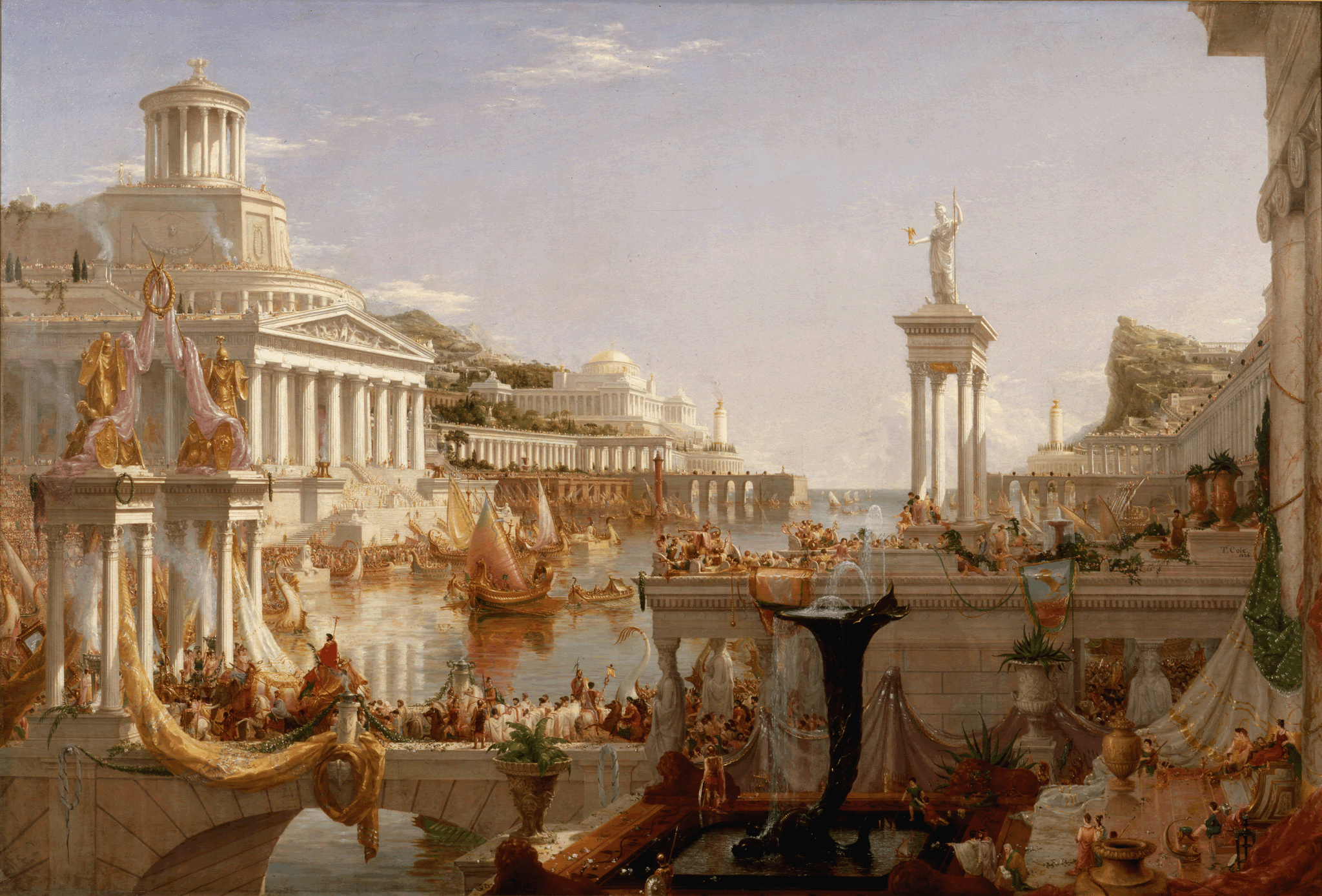The Course of Empire: The Consummation of Empire

About
Decode
Compare
Cole's Process
Cole's Words
Locate
About
"The third picture must be a noonday—a great city girding the bay, gorgeous piles of architecture, bridges, aqueducts, temples—the port crowded with vessels —splendid processions &c.—all that can be combined to show the fullness of prosperity: the chiaroscuro broad." 1
Decode
Mouse over the detail to view its caption, click it to zoom in, and use the reset button on the lower right to zoom back out.
1. Manmade structures now cover the mountain, which is completely subject to human domination.
2. Of the five paintings in the series, The Consummation of Empire was most influenced by Cole's trip to Europe in 1829-32. The Greek Doric temple contains pediment sculptures depicting a hunting scene like that in The Savage State. Cole copied the central figure of Diana, Roman goddess of the hunt, from the Hellenistic sculpture Diana of Versailles, which he would have seen in Paris.
3. The 1830s saw a period of intense debate between the populist Democratic party and the elitist Federalist party over how the United States should be governed. Cole, who identified strongly with his aristocratic patrons, supported the Federalists. Some historians believe that this image of a grandiose ruler entering the city in an elephant-drawn car may be an unflattering allusion to the then-current Democraticpresident, Andrew Jackson.
4. Spears and other military garb suggest a thoroughly militarized society.
5. The statue of Athena symbolizes war and victory.
6. A philosopher stands surveying the scene. Cole's signature carved into the stone suggests that he identified with this figure's detached observation.
7. The potted plant symbolizes human control over nature. The vase is modeled after a Greek vessel known as the Borghese Vase, in the collection of the Louvre, which Cole may have seen in Europe.
8. The two boys prefigure events to come: while it appears that the children are playing amicably, the older boy is actually sinking his playmate's toy ship.
9. A scholar records history as it happens, parallel to Cole's role in creating another kind of record through pictures.
10. A fountain represents human manipulation and diminishment of the natural elements.
11. Brass trumpets replace the simple flutes of the pastoral state, suggesting a shrill and overblown quality to the cultural developments of the era.
Compare
Joseph Mallord William Turner, Dido Building Carthage, or the Rise of the Carthaginian Empire, oil on canvas, 1815, 61 7/10 x 91 3/10 in. The National Gallery, London, Turner Bequest, 1856, NG498. View in Scrapbook
Cole drew inspiration for The Consummation of Empire from Turner's Dido Building Carthage. After seeing the work in a London studio in 1829, Cole wrote, "The building of Carthage is a splendid composition & full of poetry. Magnificent piles of Architecture, some finished and some incomplete, fill the sides of the picture while the middle of it is a bay or arm of the sea that comes to the foreground, glittering in the light of the sun which rises directly over it. The figures, vessels, sea are very appropriate. The composition very much resembles some of Claude's." 1 Note the similarities between the architecture of both paintings, with their romanticized classical temples and rivers running through the center of the compositions. Note also the two boys playing with ships in Turner'swork, as in Cole's painting.
Process
A fitting apex to the series, Consummation is the largest and most complex of all the works. Cole's installation diagram shows how he intended the paintings to be arranged around the mantle in Luman Reed's gallery. Consummation is the fulcrum around which all the other paintings are arranged. Given Cole's difficulties with rendering human figures, his ambitious composition posed an enormous challenge. Regarding this work, he called the chiaroscuro"broad"—his way of describing the overall brightness of the scene. Light—usually a positive formal element in a painter's repertoire of visual symbols—is here associated with an overripe, decadent civilization.
Works
1. Thomas Cole, Installation Diagram for the Course of Empire, pen and brown ink over graphite pencil on off-white wove paper, 1833, 9 7/8 x 13 1/8 in. Detroit Institute of Arts, Founders Society Purchase, William H. Murphy Fund, 39.351. View in Virtual Gallery
2. Thomas Cole, The Course of Empire: The Consummation of Empire, oil on canvas, 1836, 51 x 76 in. Collection of The New-York Historical Society, 1858.3.
Words
While we were in the valley we heard the shouts of a company of Jacksonians who were rejoicing at the defeat of the Whigs of this county. Why were they rejoicing? because of the triumph of good principles of the cause of virtue & morality? No! but because their party was victorious! 1
I have of late felt a presentiment that the Institutions of the U[nited] States will ere long undergo a change—that there will be a separation of the States. Riot & public murder are common occurrences; every newspaper brings accounts of the laws violated not by individuals merely but by organized societies who act in defiance of the lawfully constituted authorities. What a weakness this proves in the government! It appears to me that the moral principle of the nation is much lower than formerly, much less than vanity will allow. Americans are too fond of attributing the great prosperity of the country to their own good government instead of seeing the source of it in the unbounded resources & favorable political opportunities of the nation.
It is with sorrow that I anticipate the downfall of this republican government; its destruction will be a death blow to Freedom, for if the Free government of the U States cannot exist a century where shall we turn? ...May my fears be foolish; a few years will tell. 2
Find it here.
